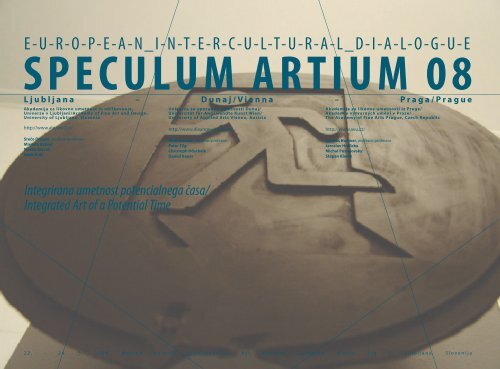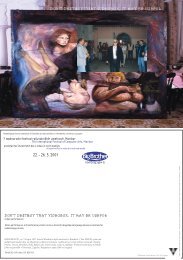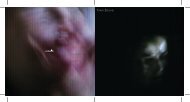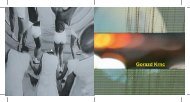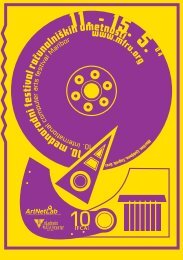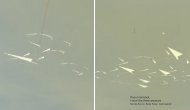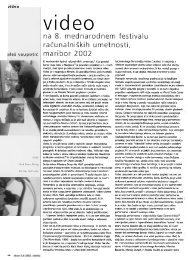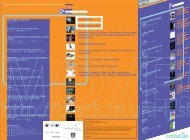europea-n_i-ntercultura-l_d-ialogue
europea-n_i-ntercultura-l_d-ialogue
europea-n_i-ntercultura-l_d-ialogue
Create successful ePaper yourself
Turn your PDF publications into a flip-book with our unique Google optimized e-Paper software.
E-U-R-O-P-E-A-N_I-N-T-E-R-C-U-L-T-U-R-A-L_D-I-A-L-O-G-U-E<br />
SPECULUM ARTIUM 08<br />
Ljubljana – Dunaj/Vienna – Praga/Prague<br />
Akademija za likovno umetnost in oblikovanje,<br />
Univerze v Ljubljani/Academy of Fine Art and Design,<br />
University of Ljubljana, Slovenia<br />
Univerza za uporabne umetnosti Dunaj/<br />
Universität für Angewandte Kunst Wien/<br />
University of Applied Arts Vienna, Austria<br />
Akademija za likovne umetnosti iz Prage/<br />
Akademie výtvarných umění v Praze/<br />
The Academy of Fine Arts Prague, Czech Republic<br />
http://www.alu.uni-lj.si/<br />
Srečo Dragan, profesor/professor<br />
Mirjana Batinić<br />
Marko Glavač<br />
Iztok Holc<br />
http://www.dieangewandte.at/<br />
Ruth Schnell, profesor/professor<br />
Peter Tilg<br />
Christoph Höschele<br />
Daniel Kauer<br />
http://www.avu.cz/<br />
Markus Huemer, profesor/professor<br />
Jaroslav Hrdlicka<br />
Michal Pustejovsky<br />
Stepan Klenik<br />
Integrirana umetnost potencialnega časa/<br />
Integrated Art of a Potential Time<br />
22. – 24. 5. 2008, Mestna galerija Ljubljana/City Art Museum Ljubljana, Mestni trg 5, Ljubljana, Slovenija
Okultizem in obskurizem črne škatle v medijski<br />
umetnosti: Carcere (01) in Carcere (02)<br />
Arhitekturne vizije Giovannija Battiste Piranesija lahko<br />
razumemo kot projekcije notranjega jaza, s tem pa se nam<br />
odpira eden od možnih pogledov na problematiko medijske<br />
umetnosti: arhitektura računalniškega softvera in arhitektura<br />
črne škatle v inštalacijah medijske umetnosti sta podobno<br />
obskurni in celo okultni kot je arhitekturni svet bakrorezov z<br />
naslovom Carceri. Piranesi je ustvaril omenjene ječe v letih<br />
1742/43 ter se k njim vrnil še enkrat leta 1761. To niso le<br />
njegova najpomembnejša dela, ampak so prelomna tudi v<br />
okvirih umetnostne zgodovine. Kot popolnoma fantazijski<br />
svetovi predstavljajo arhitekturne rešitve »negativnih<br />
utopij«. Piranesijeve ječe napovedujejo umetnost surrealizma.<br />
Strukturno so bolj podobne »čistemu zlu« (prim. Immanuel<br />
Kant, Religija znotraj meja samega uma, 1793), čudnim, celo<br />
okultnim sanjam kot pa arhitekturi. Negirajo čas, premeščajo<br />
prostore in jih vzporejajo z novozgrajenimi hibridnimi<br />
svetovi, nakazana je ukinitev gravitacije, vznemirjenje ob<br />
nemogočem se staplja z nadnaravnimi fenomeni, ki jih ni<br />
mogoče znanstveno razložiti.<br />
Piranesijeve vizije ponavljajo podobne si, temačne<br />
arhitekturne elemente v neskončnost, gradijo brezmejna<br />
klavstrofobična prizorišča. Celo ko jih razumemo zgolj v<br />
metonimičnem smislu, so še vedno obskurne, saj se hodniki,<br />
stopnice, lestve in mostovi nizajo v neskončnost brez izhoda.<br />
Carceri so sestavljeni iz arhitekturnih elementov vseh<br />
preteklih stoletij. To seveda še ne pomeni, da fantastične<br />
arhitekturne vizije in slike ruševin pred renesanso niso<br />
obstajale, prav tako ni arhitekturni eklekticizem novost ali<br />
osrednji vidik – najdemo ga npr. že v delih Monsù Desideria –<br />
gre bolj za nenavadni sinkretizem arhitekturnih slogov, ki<br />
zbuja občutje ujetosti v neskončnem sprehodu med sobami,<br />
zrcalnimi podobami in ponavljanji. Prav tu najdemo<br />
sorodnost s surrealizmom.<br />
Danes lahko najdemo podobna neskončna ponavljanja in<br />
zrcaljenja v virtualnih svetovih, ki jih gradimo s pomočjo<br />
računalnika s ponavljajočimi se algoritmičnimi zankami v<br />
računalniških programskih nizih. Podobno kot se<br />
arhitekturni slogi Piranesijevih ječ sinkretistično sestavljajo,<br />
tudi sodobni programski jeziki kot npr. Java uporabljajo<br />
odprtokodne predprogramirane segmente iz matrice. »V<br />
neprostoru matrice poseduje notranjščina določenega<br />
podatkovnega konstrukta neomejene subjektivne<br />
dimenzije,« piše William Gibson v knjigi Nevromant. CASE<br />
(Computer Aided Software Engineering) se uporablja za<br />
oblikovanje raznolikih grafičnih vmesnikov in podatkovnih<br />
zbirk. Case je obenem tudi ime junaka Gibsonovega romana<br />
iz leta 1984. Case zasleduje sanje, ki so jih ustvarili programi,<br />
izgublja se v podatkovni zbirki, v diagramu računalniškega<br />
vezja, ki zajema ves svet, priklopi se prek krova za vstop v<br />
kibersvet, ki njegovo raztelešeno zavest projicira v skupinsko<br />
halucinacijo matrice.<br />
Pretanjen psihološki avtomatizem je najti tako v kompleksni<br />
programski arhitekturi računalniških mrež kot v Piranesijevih<br />
arhitekturnih svetovih. V obeh primerih gre za surrealističen<br />
pritisk psihe na mišljenje, ki se ne ozira na razum, estetske in<br />
etične postavke. Virtualni svetovi, posebej kibersvet, in<br />
Piranesijevi svetovi temeljijo na surrealističnem verovanju v<br />
višjo realnost zanikanih asociacij, opomnikov o prevladi sanj<br />
in halucinacij nad razumom. Ena osnovnih predpostavk<br />
surrealizma je obstoj še ene dimenzije realnosti, ki je nad<br />
ravnjo zdravega razuma in vsakdanje logike in je zato<br />
poimenovana kot nad-realnost.<br />
V obeh primerih, Piranesijeve arhitekture ječ in arhitekture<br />
računalniških programov, je osamljenost izenačena z<br />
izključenostjo iz zunanjega sveta, kot zamolkla svetloba<br />
čudnih stanj zavesti in sanj v opijski omami. Znotraj teh se<br />
odvija zgodba, v kateri je meja med realnostjo in domišljijo<br />
zabrisana. Arhitekturni formi v omenjenih primerih nista<br />
simbolični ekspresiji notranje senzibilnosti in temnih počutij<br />
umetnika, ampak sta rojeni neposredno iz razuma. Sta svet<br />
okultnih sanj, pripisan silni moči človeške duše in obskurni<br />
domišljiji, v kateri se stvarnik giblje kot bitje lastne kreacije.<br />
Arhitektura obeh je animirana. Obstajajo določene povezave<br />
med človeško dušo, notranjim jazom in animirano<br />
arhitekturo. In umetniška domišljija je obskurna, saj njeni<br />
sestavni deli, kosi programa – arhitekturni blodnjaki tako<br />
rekoč – skrivajo temne skrivnosti.<br />
V svetu notranjega jaza je ta sam svoj bog, tisti ki ustvarja in<br />
opazuje svoj svet. Samo v tem svetu jaza se umetnost lahko<br />
razvije v smislu sinestezije, ki združuje čas in prostor.<br />
Skrivnost subjekta razkriva transcendentalno praznino. Vse<br />
obskurne zablode poniknejo v katarakt in posledično,<br />
arhitektura, v kateri so lahko predstavljeni digitalni virtualni<br />
svetovi v fizičnem svetu, je črna škatla, ki je tako temna, da<br />
njena izolacija skorajda nakazuje neskončne ponovitve.<br />
Tako se v inštalaciji, ki je redundantno poimenovana Črna<br />
škatla, ne vidi nič drugega kot zatemnjena soba, ki je bila<br />
pobarvana črno in v kateri na projekcijski površini, ki je ostala<br />
bela sredi črne stene, vseeno ni projekcije. Gledalec je ob<br />
vstopu v Črno škatlo zmeden, saj bele površine ne vidi takoj.<br />
Postopoma se mu oči privadijo na temo in bela, svetleča<br />
površina postaja vse bolj vidna. Je neke vrste nadomestilo za<br />
ekran, saj zavzema mesto v prostoru, kjer gledalec pričakuje<br />
projekcijo, s tem pa že vzpostavlja pogoje zidov bele<br />
galerijske kocke, ki predstavljajo intelektualno projekcijsko<br />
površino za kontemplacijo tradicionalnih slik, predstavljenih<br />
v njej. Inštalacija ni »umetnost o umetnosti« ampak logičen<br />
razmislek o pogojih, v katerih se umetnost predstavlja. Črna<br />
škatla, prazna in brez vsakršne opreme, postane umetniško<br />
delo. Črna škatla novih vizualnih medijev, praznega<br />
razstavnega prostora medijske umetnosti, je tako idealna<br />
slika s tridimenzionalno površino. Ta ekstremno reduciran in<br />
strogo konceptualen prostor za predstavitev medijske<br />
umetnosti, črna škatla, je animirana arhitektura. Je najbolj<br />
povzdignjena oblika slikarstva, z njenimi implicitnimi<br />
obsesijami in sublimacijo. Temna arhitektura, v kateri je<br />
predstavljena medijska umetnost, ni samo ontološki strah,<br />
ampak prej simbol sestopa v neskončnost notranjega jaza.<br />
Oddaljevanje od bele kocke in njenih predpostavk, kot so<br />
singularnost umetniškega dela in kult genialnega umetnika,<br />
je bilo eno izmed izhodišč za medijsko umetnost, vendar pa<br />
se prav te okoliščine vračajo v inštalacije skozi zadnja vrata.<br />
Teh okoliščin ne ustvarja sveta bela kocka, ampak prav<br />
navidezno obskurna, okultna, mitična in sakrosanktna črna<br />
škatla; vsak virtualni pobeg iz realnega sveta je ilustracija<br />
singularnosti umetniškega dela in umetnika.<br />
Markus Huemer<br />
Occultism and Obscurism of the Black Box in Media Art<br />
Carcere (01) and Carcere (02)<br />
Conceiving of Giovanni Battista Piranesi's architectural fantasies<br />
as projections of the inner self may represent one possibility of<br />
thematically addressing a fundamental problem of media art: the<br />
architecture of software programs and the architecture of the<br />
black box in media art installations function in a manner that is no<br />
less obscure, or even occult, than the architectural world<br />
rendered in the Carceri copper plates. The architect created these<br />
"dungeons" in 1742/43 and reworked them again in 1761. They<br />
are not only considered his major works, they can also be seen as<br />
something completely new in terms of art history. They are a<br />
world of imagination, pure phantasmagoria, and their aesthetics<br />
result in the strangest architectural forms of "negative utopias".<br />
What is new about Piranesi's Carceri is their anticipation of<br />
Surrealism. They are more similar in structure to a "radically evil"<br />
(cf. Immanuel Kant, Religion within the Limits of Reason Alone,<br />
1793), bizarre, even occult dream than to architecture. In them,<br />
the negation of time, the shifting of space paralleled by the<br />
simultaneous creation of hybrid spaces, the suggested and<br />
imagined suspension of gravity and the thrill of the impossible<br />
merge with supernatural phenomena that cannot or have not<br />
been scientifically explained.<br />
Piranesi's visions always replicate the same, or similarly dark,<br />
architectural elements ad infinitum, they suggest endlessly<br />
claustrophobic situations. Even when considered only in the<br />
metonymic sense, they can be described as obscure, since the<br />
corridors, stairs, ladders and bridges run on forever, while never<br />
revealing an exit. Furthermore, the Carceri assembled using<br />
architectural elements and relics from every century. This is not to<br />
say that fantastic architecture and paintings of ruins had not been<br />
found since the end of the Renaissance. Nor was their<br />
architectural eclecticism the really innovative or essential<br />
element - it could, for example, already be found in the work of<br />
Monsu Desiderio - it is more the peculiar syncretism of<br />
architectural styles, a syncretism, that aims at a sense of closure<br />
through endless flights of rooms, mirror images and repetitions.<br />
And exactly therein lies the proximity to Surrealism.<br />
A contemporary manifestation of the endless mirror images and<br />
repetitions found in Piranesi's architectural worlds can be found<br />
in the virtual worlds created by computers, in the repetitive loops<br />
and algorithms used in their program strings. Just as the<br />
architectural styles of the Carceri come together syncretistically,<br />
modern programming languages, such as Java, draw upon<br />
previously programmed segments from the matrix, which are<br />
available as open-source-code. "In the nonspace of the matrix,<br />
the interior of a given data construct possessed unlimited<br />
subjective dimension", writes William Gibson in his brilliant novel<br />
Neuromancer. "Computer Aided Software Engineering" (CASE) is<br />
used in designing diverse graphical interfaces and databases.<br />
Case is also the name of the hero in the cyberspace world created<br />
in Gibson's 1984 novel. Case is the protagonist in an endless<br />
computer story, an escape from the real world into cyberspace.<br />
Case is pursuing a dream created by programs, he is lost in the<br />
database, the circuit diagram of a world computer, he jacks "into<br />
a custom cyberspace deck" and it projects "his disembodied<br />
consciousness into the consensual hallucination that … [is] …<br />
the matrix."<br />
A delicate psychological automatism is found in both the<br />
complex program architecture of computer networks and in<br />
Piranesi's architectural worlds. In both worlds one discovers a<br />
surreal dictate of the psyche to think without being controlled by<br />
reason, beyond all aesthetic and ethical considerations. The<br />
virtual worlds, particularly those in cyberspace, and the worlds<br />
created by Piranesi are based on a surrealist belief in the higher<br />
reality of neglected associations, reminders of the omnipotence<br />
of dreams and hallucinations. Thus, Surrealism is not found in the<br />
immaterial world of the hereafter. One of its primary implications<br />
is the assumption of the existence of another dimension of reality,<br />
one that is on a level above common sense and everyday logic,<br />
hence a "sur-reality".<br />
Both in the architecture of computer programs and in Piranesi's<br />
dungeons, loneliness is equated with being excluded from the<br />
outside world, the dimming of light of bizarre states of<br />
inebriation and opium-induced dreams. In them, a story takes<br />
place, in which the border between reality and fantasy become<br />
blurred. Neither form of architecture is the symbolic expression of<br />
the innermost sensibilities, of the dark moods of the artist-author,<br />
they were born directly of the mind. They are the world of an<br />
occult dream, to the extent that it ascribes to the overwhelming<br />
power of the human soul, and of an obscure imagination, in<br />
which the creator moves about as a creature of his own making.<br />
At the same time, the architecture of Carceri and of programming<br />
languages is animated. There is ultimately some correspondence<br />
between the human soul, one's own inner self, and animated<br />
architecture. And the artistic imagination is obscure, because its<br />
constituent parts, the program elements - the architectural<br />
aberrations, so to speak - seem to harbor dark secrets.<br />
Within this universe of the inner self, the inner self is its own god,<br />
one that creates and observes its own world. It is only in this<br />
universe of the self that the arts can be fully developed in a<br />
synaesthetic sense, unifying space and time. The enigma of the<br />
subject reveals the transcendental vacuum. All obscure<br />
aberrations sink into a cataract, and, consequently, the<br />
architecture in which digitally based virtual spaces can be<br />
presented in the physical world is the black box, so dark that its<br />
isolation seems to indicate endless repetitions.<br />
Hence, in an installation that is redundantly entitled Black Box,<br />
nothing can be seen but a darkened room that has been painted<br />
black, and, although a projection surface has been left white in<br />
the middle of the black wall at the front, there is no projection.<br />
The viewer is at first confused when entering the Black Box, since<br />
the white space cannot be immediately recognized in the<br />
darkness. Gradually the eyes become used to the dark, and the<br />
white, luminous surface becomes increasingly visible. It is a kind<br />
of substitute for the screen, it appears in the spatial location<br />
where the viewer expects to see a projection, laying claim to the<br />
wall referentially as an "intellectual" projection surface of the<br />
white cube and the traditional type of painting presented in it.<br />
The installation is not "art about art", but rather, logically, a<br />
reflection of the conditions under which art is presented. The<br />
black box itself, empty and without any equipment, becomes a<br />
work of art in its own rite. The black box of the new visual media,<br />
of the empty exhibition space of media art, is thus a "perfect<br />
painting with a three-dimensional surface. This extremely<br />
reduced and, as it initially seems, austerely conceptual spatial<br />
setting for what is called media art, the black box, is animated<br />
architecture; it is the most exalted form of painting with its<br />
implicit obsessions and sublimation. The dark architecture in<br />
which media art is presented is not only an ontological fear, but<br />
rather a symbol of the descent into the endlessness of the inner<br />
self.<br />
While distancing itself from the white cube and its implications,<br />
like singularity of the work and the cult of genius surrounding the<br />
artist, originally, was one of the axioms of media art, these are the<br />
very conditions that are creeping back into installations, albeit<br />
through the back door. It is not the holy white cube that creates<br />
such conditions, but rather the - seemingly obscure, occult,<br />
mythic and sacrosanct - black boxes; each virtual escape from the<br />
real world is an illustration of the singularity of the work of art and<br />
of the artist.<br />
Markus Huemer
Markus Huemer: Carcere (01) Instalacija/Installation, 2002. DVD, DVD predvajalnik/player, projektor/beamer. Različne dimenzije/Variable<br />
dimensions. Private Collection, Wiesbaden.<br />
Carcere (02) Instalacija/Installation, 2005. DVD, DVD predvajalnik/player, projektor/beamer. Različne dimenzije/Variable dimensions. Collection Ploner, Vienna.<br />
1
Srečo Dragan: Metamorfoza Lingvistika/Metamorphosis of Language<br />
Intermedijska spletna instalacija/Intermedia net installation, 2007. Programiranje/Coding: Damjan Kužnar, Matic Standeker, Leon Oven, Benjamin<br />
Ambrož, Branko Pinter, Blaž Marn. Zahvala/Thanks to: dr. Matjaž Jogan, dr. Borut Batagelj Laboratorij za računalniški vid, Fakulteta za računalništvo in<br />
informatiko UL/Computer Vision Laboratory, Faculty of Computer and Information Science, University of Ljubljana. http://black.fri.uni-lj.si/2007/mol/<br />
Kognitivna emocionalna interakcija raziskuje specifiko režima negativnih in pozitivnih čustev v jeziku. Metamorfoza lingvistika je<br />
spletni umetniški projekt, v katerem udeleženec vstopa enkrat v podatkovno zbirko slovenskega jezika in drugič v angleški jezik. Z<br />
izbranima ključnima opozicijskima besedama in slovnico kot inventarjem simbolnih enot se udeleženec na sebi lasten način<br />
jezikovno izrazi. V tem procesu upodabljanja in uprizarjanja sheme podobe kot predkonceptualnega vzorca človek ureja fizično in<br />
mentalno izkušnjo zavedanja sebe znotraj psihološkega, sociološkega in kulturnega konteksta sporazumevanja.<br />
A cognitive and emotional interaction researches the specifics of the regime of negative and positive feelings in language. Metamorphosis<br />
of Language is a net-based art project into which the participant enters – the first time he enters the database of Slovenian<br />
language and the second time he enters the database of the English language. Two selected opposite keywords and the grammar<br />
serving as an inventory of symbolic units, allow the participant to express himself in a unique manner. Through this process of<br />
creating imagery and the image-scheme as pre-conceptual patterns, man arranges the material and mental experience of<br />
self-perception within the psychological, sociologic and cultural context of communication.<br />
2
Ruth Schnell: Vzorci zaznave II/Patterns of Perception II<br />
Mediapan/MDF plate, epoxy smola/resin, 32 svetlečih diod/bar of light with 32 white LED`s, Paltine, EPROM s 100 besedami/EPROM with 100 words, transformator/transformer, 2004/2005.<br />
www.ruthschnell.org www.galeriegritainsam.at<br />
Delo iz serije slik narejenih s svetlobo razkriva raznolikost vidikov raziskave umetne svetlobe v delih Ruth Schnell. Avtorica raziskuje problematiko nematerialne svetlobe na fizikalni, konceptualni<br />
in oblikovalski ravni, tako da estetizira nastanek monokromatične rdeče slike. Stolpec belih svetlečih diod je bil vstavljen v gladko prosojno površino. Ko gledalec na hitro pogleda<br />
stran, stolpec svetlobe ustvari različne besede, ki gradijo sliko prostorskega holograma za delček sekunde. Ruth Schnell tako deluje na ravni »po-slike«, ki nastaja na mrežnici in jo dekodirajo<br />
možgani. Visokofrekvenčni impulzi ustvarjajo črke le v primeru, ko gledalec ne gleda naravnost v sliko, ampak ko namenoma pogleda stran.<br />
As a part of the light-generated series of pictures, this piece of work reveals Ruth Schnell`s varied exploration and investigation of artificial light. She investigates problematic issues of<br />
immaterial light on a physical, conceptual and design-based level by aestheticising the creation of a monochrome-red panel picture. Here, a bar of white LEDs has been vertically inserted<br />
into the smooth translucent screen. When the viewer looks away quickly, the bar of light generates various words, which form the image of a spatial hologram for fractions of seconds at a<br />
time. Hence Ruth Schnell operates with the phenomenon of after-image that is produced on the retina and decoded by the brain. The letters produced by high frequency impulses, which<br />
flicker across the bar of light, are only recognisable as such, if the viewer deliberately looks away from rather than directly at the image.<br />
3
Christoph Höschele: Blainville-Crevon - Neuilly-sur-Seine Interaktivna videoinstalacija/interactive video installation, 2007, www.niemandsland.net/hoec<br />
Delo se nanaša na pot Marcela Duchampa med rojstnim krajem Blainville-Crevon v Normandiji in krajem, kjer je umrl, Neuilly-sur-Seine pri Parizu, pa tudi na njegov readymade »Roue de Bicyclette«.<br />
The sources for the work „Blainville-Crevon – Neuilly-sur-Seine“ are on the one hand the route Marcel Duchamp took between his birthplace in Blainville-Crevon (Normandy) and Neuilly-sur-Seine (Paris) where he died, as well as his ready-made-piece<br />
„Roue de Bicyclette“.<br />
4
Stepan Klenik: PB - Photoluminescence Board - Sketch Wall Instalacija/Installation, 2008.<br />
Nariši! Zapiši! Zaupaj se… V zatemnjeni sobi je na steno pripeta PTL folija kot slikarsko platno. Obiskovalec galerije pred vstopom v sobo prejme svetilko z zelo<br />
ozkim, vendar močnim svetlobnim žarkom - ta nadomešča čopič, s katerim obiskovalec potem riše po PTL foliji. Kako ustvarjati s svetlobnim žarkom Obiskovalec<br />
ne ustvarja samo zase, ampak tudi za druge, ki bodo prišli za njim, ter za tiste, ki ustvarjajo sočasno z njim, možno je interagirati s predhodnimi sporočili in slikami.<br />
Platno ne bo nikoli polno, saj sled svetlobe na njem sčasoma izginja.<br />
Draw it! Write it down! Make confidence ... The photoluminescent foil attached to the wall in a darkened room is basically a big picture, an outsized canvas. The<br />
torch is a substitution for a brush, with which the visitor can paint on the foil. How to create images with a ray of light A spectator does not create only for himself<br />
but for others, present visitors and those who will come after he leaves. Interception of previous drawings and messages makes a field for reaction. The canvas will<br />
never be full, since as the time proceeds, the crystals discharge and the track of light disappears.<br />
PW - Photoluminescence Wisdom - Wall Sketches Instalacija/Installation, 2008.<br />
Krhko sporočilo. Zapuščina ni večna. Sporočilo traja, kolikor časa sije v tvojih mislih.<br />
Tokrat obiskovalec ne riše ali piše v temi, ampak naključno odkriva že napisana sporočila na steni, s tem ko osvetljuje dele sobe. (Sporočila so nastala med<br />
performansom v galeriji in so bila namenjena razstavi SPECULUM ARTIUM 08.) Obiskovalec jih bere fragmentarno, iz delov ustvarja nove celote.<br />
Fragile message. The legacy is not eternal. The message lasts as long as it shines in your mind.<br />
The spectator/visitor randomly picks up messages written on the walls of a darkened room by accidentally illuminating areas covered with photoluminiscent texts.<br />
(The texts were born during the performance in the gallery and they were addressed for the exhibition SPECULUM ARTIUM 08). The visitor illuminates fragments,<br />
chooses words, constructs sentences, combines the final image.<br />
5
Iztok Holc: TH-strategije/TH-strategies<br />
Interaktivna instalacija/Interactive installation, 2008. Programiranje/Coding: Miha Vydra-Stančič.<br />
Postavitev je strategija za preoblikovanje, ukrivljanje in razklenjanje algoritma in interakcije v prostoru, kot ga zastavi<br />
kopernikovska misel, definira evklidska geometrija, metodološko uporablja razsvetljenstvo in dogmatizira zahodna<br />
religija – poskus ideje brez smeri, ampak z okusom.<br />
Display is a strategy to re-form, bend and corrupt the algorithm and interaction in space set by Copernicanism, defined<br />
by Euclid's geometry, methodologically used by the Enlightenment movement and thought and dogmatised by<br />
Western religion - an idea of no space, but taste.<br />
6
Mirjana Batinić: Dom/Home Video, 11'10'', 2008. http://batinic.atrtuska.com<br />
Video je nastal, ko sem delala na interaktivni zvočni instalaciji »Prostor doma«. Izhodišče za obe deli je isto – odnos do nove situacije, ki je rezultat selitve iz enega mesta (države) v drugo.<br />
I made the video while working on the interactive audio installation “A Place of Home”. The starting point of both works is the same – the relationship towards a new situation being a result of moving from one city (country) to another.<br />
7
Michal Pustejovsky: Fragmenti/Fragments Objekti/Objects, 2008.<br />
Cikel porcelanastih odlitkov kot namišljena arheološka najdba.<br />
A cycle of porcelain castings as a fictitious archaeological find.<br />
Ton_skulptura/Tone_sculpture Objekti/Objects, 2008.<br />
Ton_skulptura materializira vibracije skozi želatinasto snov. Želatina je material, ki ohrani spremembo oblike zaradi vibracij, po tem ko je zadušila zvok. V vosek ujeti zvok predstavlja kalup za odlivanje kovinske skulpture.<br />
Tone_sculpture materializes audio vibrations through a gel substance. The gel uniquely remains in position of vibrations after muting sound. This feature allows capturing sound to a wax figure. Wax mould is then used as form for final metal sculpture.<br />
Binarni avtoportret.png/Binary_self-portrait.png Objekt/Object, 2008.<br />
Črno-bela slika izvirne ločljivosti 320×363 točk (4,1 KB) prevedena v tok bitov, 34048 znakov. Tok bitov je nato ročno odtisnjen na aluminijast list s konico velikosti 3 mm.<br />
Black and white image of source resolution 320×363 pixels (4.1 Kb) converted to the bit stream of 34048 characters. This bit stream is then manually imprinted onto an aluminium sheet using a plunger of size 3 mm.<br />
8
Peter Tilg: Zebra je čredna žival/The Zebra is a<br />
Gregarious Animal Participativna instalacija/Participative installation, 2006.<br />
Čitalec prstnih odtisov skenira odtis osebe, ki položi prst na napravo. Prstni odtis se shrani<br />
in preslika na tridimenzionalni model belega konja, tako nastane vaša osebna zebra.<br />
Naslednja stopnja projekta natisne ustvarjene zebre.<br />
The fingerprint reader scans the fingerprint of the person who places his/her finger on the<br />
device. The fingerprint is saved and mapped onto a 3D model of a white horse. A personalised<br />
zebra is created. In a subsequent working stage prints are produced from the created zebras.<br />
9
Jaroslav Hrdlicka: Avatar Video, PAL (720x480), brez zvoka/no sound, 5'40", 2008.<br />
Beseda avatar prvič nastopi v hinduizmu, kjer pomeni inkarnacijo božanstva z določenim namenom. V kontekstu računalništva in posebej interneta se beseda avatar uporablja za poimenovanje podobe uporabnika v virtualnem svetu. Poskusil sem<br />
zgraditi avatarja s pomočjo plesalke, to pomeni, da sem uporabil podobo človeka. Pri tem postane nejasno, ali je to podoba človeka ali pa zgolj nosilca podobe.<br />
The term avatár (originally avatára) first appears in the Hinduism. The meaning of the word in sanskrt is a descent or, metaphorically spoken, the incarnation - usually a divine being incarnates into the physical body on special purpose. A word avatár or<br />
avatar is being used in the context of computers and internet for the self presentation of the user in the virtual world. I tried to search for the actual bearer with help of a professional danseuse. Thus, I employed visualisation of a human model. As for the<br />
human model it is uncertain, if it is a being or a bearer.<br />
10
Marko Glavač: Relevé Interaktivni happening/Interactive happening, 2008. Programiranje/Coding: Klavdija Krivec,<br />
Simon Gotlib, Anže Jamnik.<br />
Pet gledalcev se pojavi v realnem prostoru kot skupinski portret (P. Picasso: »Avignonske gospodične«). Ko zavzamejo<br />
točno določeno pozicijo v realnem prostoru in se nato pričnejo prosto gibati, računalniški program sproži projekcijo, ki<br />
prikazuje dekonstrukcijo kipa »Brez naslova (skupinski portret)« v virtualnem prostoru. Kip vidimo v sestavljeni obliki kot<br />
skupinski portret v trenutku, ko se gledalci v realnem prostoru pojavijo na začetni poziciji skupinskega portreta.<br />
Five viewers appear in the real space as a group portrait (P. Picasso: “The Young Ladies of Avignon”). When they place<br />
themselves in a defined position in the real space and then start to move freely, the computer program activates the<br />
projection of a deconstruction of the sculpture “Untitled (The Group Portrait)” in the virtual reality. The sculpture can be seen<br />
as a whole again in the moment, when all the viewers place themselves at their starting positions in the group portrait.<br />
11
Daniel Kauer: razostreno/out of focus Animirani film – neskončna zanka/Animated film – loop, 2007.<br />
Animirani film o naraščanju deziorientacije v procesu dela.<br />
An animated film about the state of rising disorientation within a working process.<br />
12
http://limaul.gm1.tv<br />
Speculum Artium 08: Ljubljana – Dunaj/Vienna – Praga/Prague:<br />
Integrirana umetnost potencialnega časa / Integrated Art of a Potential Time.<br />
22. – 24. 5. 2008, Mestna galerija Ljubljana/City Art Museum, Mestni trg 5, Ljubljana, Slovenija.<br />
Organizator/Organizer: Akademija za likovno umetnost in oblikovanje UL/Academy of Fine Art<br />
and Design, University of Ljubljana, Slovenia.<br />
CIP - Kataložni zapis o publikaciji<br />
Narodna in univerzitetna knjižnica, Ljubljana<br />
73/76(4)"20"(083.824)<br />
INTEGRIRANA umetnost potencialnega časa = Integrated art of a potential time : Speculum<br />
Artium 08, Ljubljana - Dunaj, Vienna - Praga, Prague : 22.-24. 5. 2008, Mestna galerija<br />
Ljubljana, City Art Museum Ljubljana, Mestni trg 5, Ljubljana, Slovenija / [organizator<br />
Akademija za likovno umetnost in oblikovanje = organizer Academy of Fine Art and Design ;<br />
besedila Srečo Dragan, Markus Huemer ; urednika Narvika Bovcon, Aleš Vaupotič ; prevodi<br />
Aleš Vaupotič ; fotografije Miha Benedičič]. - Ljubljana : Akademija za likovno umetnost in<br />
oblikovanje, 2008<br />
ISBN 978-961-91062-6-6<br />
1. Vzp. stv. nasl. 2. Bovcon, Narvika 3. Akademija za likovno umetnost in oblikovanje<br />
(Ljubljana)<br />
240066560<br />
Razstavni odbor/Exhibition board: Srečo Dragan, Markus Huemer, Peter Weibel.<br />
Besedila/Texts: Srečo Dragan, Markus Huemer.<br />
Kustosa, urednika kataloga/Curators, catalogue editors: Narvika Bovcon, Aleš Vaupotič.<br />
Založila/Published by: Akademija za likovno umetnost in oblikovanje UL/Academy of Fine Art<br />
and Design, University of Ljubljana, Slovenia.<br />
Zanjo/Presented by: Bojan Gorenc.<br />
Prevodi/Translations: Aleš Vaupotič.<br />
Fotografije/Photographs: Miha Benedičič.<br />
Oblikovanje/Design: Narvika Bovcon, riii.<br />
Tisk/Print: VZA Logatec.<br />
Naklada/Number of copies: 500.<br />
Ob podpori/With kind support of: Ministrstvo za kulturo Republike Slovenije/Ministry of Culture<br />
of the Republic of Slovenia, Mestna občina Ljubljana/Municipality of Ljubljana, Univerza za<br />
uporabne umetnosti Dunaj/University of Applied Arts Vienna, Austria, Akademija za likovne<br />
umetnosti iz Prage/The Academy of Fine Arts Prague, Czech Republic, Fakulteta za računalništvo<br />
in informatiko UL/Faculty of Computer and Information Science Univerze v Ljubljani, Mestna<br />
galerija Ljubljana/City Art Museum Ljubljana, Inea Toshiba.<br />
Zahvala/Special thanks to: Veronika Schnell, Jiří Ševčík, Anetta Mona Chisa, Aleksander Bassin,<br />
Sarival Sosič, Dušan Bučar, Franc Solina, Borut Batagelj, Matjaž Jogan.
V duhu vrednot demokracije in slovenskega predsedovanja Evropi<br />
v prvi polovici letošnjega leta Akademija za likovno umetnost in<br />
oblikovanje predstavlja razstavo medkulturnega dialoga med<br />
tremi evropskimi akademijami.<br />
Na njej se predstavljajo z deli študenti in njihov profesor Markus<br />
Huemer z Akademije za likovne umetnosti iz Prage, umetniška dela<br />
študentov in profesorice Ruth Schnell z Univerze za uporabne<br />
umetnosti na Dunaju, skupaj z deli podiplomskih študentov<br />
ljubljanske Akademije za likovno umetnost in oblikovanje, nastalih<br />
v povezavi s Fakulteto za računalništvo in informatiko, ter deli<br />
njihovega profesorja Sreča Dragana.<br />
V izboru so študenti, ki smo jih profesorji izbrali kot izjemno<br />
nadarjene in pronicljive ustvarjalce, kateri s svojimi deli odpirajo<br />
vsa relevantna vprašanja današnje umetnosti. Gre za interdisciplinarni<br />
projektni modul mreženja različnih pedagoško-raziskovalnoumetniških<br />
konceptov in povezav z izkušnjami, ki so jih razvile<br />
posamezne akademije, in tudi toleranco do robnih alternativnih<br />
praks v svojih okoljih.<br />
V duhu postmedijskega stanja, ki ga mlade, šolajoče se generacije<br />
živijo, so to umetniške vizije, ki imajo status integrirane umetnosti,<br />
saj združuje izkušnjo slikarstva, kiparstva, grafike, videa in interaktivne<br />
instalacije, s poudarkom na nenehnem eksperimentiranju, ki<br />
danes še edino dopušča ustvarjalno svobodo.<br />
Naslov Speculum Artium se nanaša na izjavo Petra Weibla, »da ima<br />
razvoj praks participacije v umetnosti preslikavo v razvoju participacije<br />
v demokraciji in da ta procesa vplivata drug na drugega,<br />
tako kot je pojav grškega kiparstva tesno povezan z vzponom<br />
demokracije v tistem času. Od takrat je umetnost nepogrešljiv<br />
pogoj za delovanje demokracije.«<br />
Upamo, da bo predstavitev v obliki razstave v realnem prostoru<br />
Mestne galerije v Ljubljani, v času od 22. do 24. maja 2008, ter v<br />
virtualnem prostoru interneta kot oblike direktnega prenosa<br />
dogajanja v delavnici ustvarjanja lastnega TV kanala treh likovnih<br />
akademij in Fakultete za računalništvo in informatiko iz Ljubljane, v<br />
povezavi z Grand Medio iz Beljaka iz Avstrije, uspešen in odmeven<br />
prispevek, tako za akademsko sfero kot za »med-kulturni dialog«<br />
umetnosti Evrope.<br />
Prof. Srečo Dragan, ALUO Ljubljana<br />
3×S<br />
ALUO/LJ/SLO<br />
UAK/W/A<br />
ARTIUM<br />
SPECULUM 08<br />
AVU/P/CZ<br />
3×P<br />
In the spirit of democratic values and of the Slovenian presidency of<br />
the European Union in the first half of 2008 the Academy of Fine Art<br />
and Design from Ljubljana presents an exhibition of the<br />
inter-cultural d<strong>ialogue</strong> between three European art academies.<br />
Professor Markus Huemer and his students from the Academy of<br />
Fine Arts from Prague present their artworks alongside the works by<br />
the students and by Prof Ruth Schnell from the University of<br />
Applied Arts Vienna and the projects by postgraduate students of<br />
the Ljubljana Academy of Fine Art and Design, produced in collaboration<br />
with the Faculty of Computer and Information Science UL,<br />
and the works by their professor Srečo Dragan.<br />
The selection includes the students chosen by the professors as the<br />
most sensitive ones, who in their works touch upon all the pertinent<br />
issues of our time. It is a networking module on the level of the<br />
interdisciplinary project connecting multiple pedagogic-researchartistic<br />
concepts and links with the experiences of different<br />
academic institutions and, in addition to that, also the tolerance<br />
towards the alternative social practices in their home environments.<br />
In the spirit of the postmedia condition, being the living environment<br />
of today’s student generations, we stand before artistic visions<br />
with the status of integrated art, which combines the know-how of<br />
painting, sculpture, graphics, video and interactive installation with<br />
the constant emphasis on experimentation that is the only place<br />
left today for the artistic freedom.<br />
The title Speculum Artium refers to Peter Weibel’s statement “that<br />
the development of participatory practices in the arts has its<br />
counterpart in the advancement of a participatory democracy and<br />
that these processes have a mutual effect on each other, just as the<br />
emergence of Greek sculpture was closely linked to the emergence<br />
of Greek democracy at that time. Since then, art has been an<br />
indispensable condition for a functioning democracy.”<br />
We hope that the exhibition in real space in the City Art Museum<br />
Ljubljana, 22 – 24 May 2008, and in the virtual space of the Internet<br />
in the form of an immediate broadcast of the events in a workshop<br />
of creating a new TV channel of the three academies and the Faculty<br />
of Computer and Information Science from Ljubljana, in association<br />
with Grand Media from Villach, Austria, a successful contribution<br />
with wide repercussions as well for the academic sphere as for the<br />
“inter-cultural d<strong>ialogue</strong>” of the European art.<br />
Prof Srečo Dragan, Academy of Fine Art and Design Ljubljana


